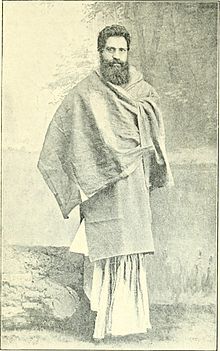Swami Shraddhanand
Swami Shraddhanand | |
|---|---|
 | |
| Born | 22 February 1856 |
| Died | 23 December 1926 (aged 70) Delhi, India |
| Cause of death | Assassination |
| Known for | Social worker Freedom Fighter Independence Activist Teacher Religious Leader |
Swami Shraddhanand (22 February 1856 – 23 December 1926), also known as Mahatma Munshi Ram Vij,
Early life and education

He was born on 22 February 1856 in the village of Talwan in the
He adopted
Meeting Dayanand
He first met
Career

Schools
In 1892
In 1917, Mahatma Munshi Ram took sanyas as "Swami Shradhanand Saraswati".
Shraddhanand established Gurukul Indraprashtha in
Activism
In 1917, Shraddhanand left Gurukul to become an active member of the
He also joined the nationwide protest against the Rowlatt Act. The same year he protested in front of a posse of Gurkha soldiers at the Clock Tower in Chandni Chowk, then was allowed to proceed.[3] In the early 1920s he emerged as an important force in the Hindu Sangathan (consolidation) movement, which was a by product of the now revitalised Hindu Mahasabha.[5]
Swami Shradhanand was the only
mantras.[3]
He wrote on religious issues in both
In late 1923, he became the president of Bhartiya Hindu Shuddhi Sabha, created with an aim of reconverting Muslims, specifically 'Malkana Rajputs' in the western United Province. This brought him into direct confrontation with Muslim clerics and leaders of the time.[4][8] 1,63,000 Malkana Rajputs were converted back to Hindu fold due to this movement.[9]
Assassination


On 23 December 1926, Shraddhanand was assassinated by Abdul Rashid who said he murdered Shraddhanand over his comments on Islamic prophet Muhammad. Rashid was hanged to death in 1927. Gandhi objected to the hanging of Rashid.[10]
Today, the 'Swami Shraddhanand Kaksha' at the archeological museum of the Gurukul Kangri University in Haridwar houses a photographic journey of his life.[11]
A statue of him was placed in front of Delhi Town Hall after independence, replacing a statue of Queen Victoria.[12] This location in Old Delhi is termed ghantaghar because the old clock tower stood here until the 1950s.[13]
Personal life
Shraddhanand and his wife Shiva Devi had two sons and two daughters. His wife died when Shraddhanand was only 36 years old. His granddaughter Satyavati was a prominent opponent of the British rule in India.[14]
See also
Bibliography
- The Arya Samaj and Its Detractors: A Vindication, Rama Deva. Published by s.n, 1910.
- Hindu Sangathan: Saviour of the Dying Race, Published by s.n., 1924.
- Inside Congress, by Swami Shraddhanand, Compiled by Purushottama Rāmacandra Lele. Published by Phoenix Publications, 1946.
- Kalyan Marg Ke Pathik (Autobiography:Hindi), New Delhi. n.d.
- Autobiography (English Translation), Edited by M. R. Jambunathan. Published by Bharatiya Vidya Bhavan, 1961
Further reading
- Swami Shraddhanand, by Satyadev Vidyalankar, ed. by Indra Vidyavachaspati. Delhi, 1933.
- Swami Shraddhanand (Lala Munshi Ram), by Aryapathik Lekh Ram. Jallandhar. 2020 Vik.
- Swami Shraddhanand, by K.N. Kapur. Arya Pratinidhi Sabha, Jallandhar, 1978.
- Swami Shraddhanand: His Life and Causes, by J. T. F. Jordens. Published by Oxford University Press, 1981.
- Section Two:Swami Shraddhanand . Modern Indian Political Thought, by Vishwanath Prasad Varma. Published by Lakshmi Narain Agarwal, 1961. Page 447.
- Chapt XI: Swami Shraddhanand. Advanced Study in the History of Modern India : 1920–1947. by G. S. Chhabra. Published by Sterling Publishers, 1971. Page 211
- Pen-portraits and Tributes by Gandhiji: '(Sketches of eminent men and women by Mahatma Gandhi)', by Gandhi, U. S. Mohan Rao. Published by National Book Trust, India, 1969. Page 133
- Swami Shraddhanand – Indian freedom fighters: struggle for independence. Anmol Publishers, 1996. ISBN 81-7488-268-5.
- Telegram to Swami Shraddhanand, (2 October 1919) – Collected Works, by Gandhi. Published by Publications Division, Ministry of Information and Broadcasting, Govt. of India, 1958. v.16. Page 203.
- An article on Swami Shraddhanand in "The Legacy of The Punjab" by R M Chopra, 1997, Punjabee Bradree, Calcutta,
References
- ^ "Swami Shraddhanand". www.aryasamajhouston.org. Retrieved 16 January 2020.
- ^ a b c Autobiography http://www.vedpedia.com Archived 2 February 2011 at the Wayback Machine.
- ^ ISBN 81-89093-08-8p. 227.
- ^ ISBN 90-04-04380-2. p. 15.
- ISBN 1-85973-348-4. p. 62.
- ISBN 9788171690428, p. 43.
- ISBN 978-93-5109-064-9.
- ISBN 0-521-24986-4. p. 194.
- JSTOR 4406586.
- ISBN 978-0-88386-711-2.
- ^ Archaeological Museum Gurukul Kangri University.
- ^ "Stories in stone", The Hindu, 20 October 2014
- ^ Clock Tower Chandni Chowk, Delhi, Early 1900s. Columbia.edu. Retrieved on 17 December 2018.
- ISBN 9780521612401.
